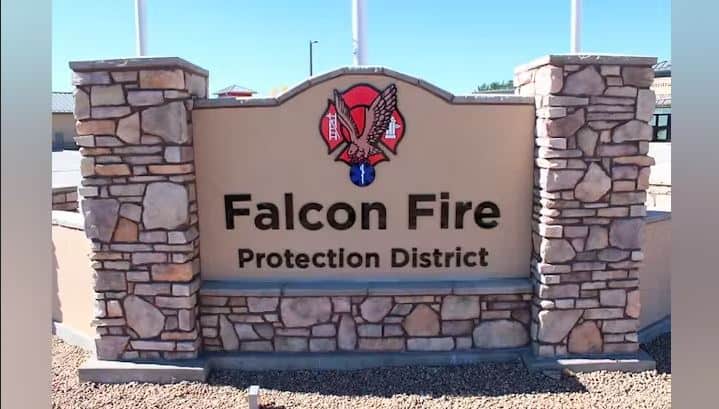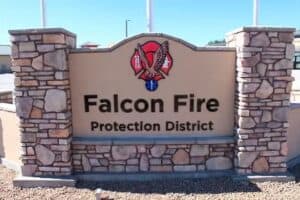By Jon Huang
This morning at Station 4 on the whiteboard is a quote from Winston Churchill.
“Success is waking from failure to failure with no loss of enthusiasm.”
At the helm of today’s crew is Lt. Brian Deckard.
Deckard moved to Peyton at age 10. His father was an Orange County firefighter whose career was cut short when he fell through a floor and broke his back. As the youngest of his siblings, Deckard often stayed at home with his mom, helping in the kitchen.
“I wanted to be a chef,” he recalls. One of his prized childhood presents was a mixer. Then, he began tagging along at the fire department where his sibling volunteered.
“I started hanging out at the station … and then I did a ride along and we ran this crazy TA.” The traffic accident involved two helicopters and two ambulances.
Deckard was hooked.
In the garage, I meet Scot Gilmore who is performing the daily truck check, the daily ritual that ensures everything is ready for the day.
Gilmore is a Colorado Springs native who started with the department in 2003. When Hurricane Katrina hit, he worked several months, which involved, among many other things, building travel trailers. In 2007, he was hit by a car as a pedestrian, broke his femur, and began a 10-year detour to get his life back together.
During this time, he managed a Wendy’s, worked building maintenance, construction— jobs he passionately disliked.
“I threw myself a little pity-party … life was a struggle and a lot of it was put on my shoulders by myself,” he reflects.
Gradually, with the help of his wife and family, he began his journey back to the job he loved.
In 2018, he was fixing a bathroom — “Angry as hell at life,” he says, when he got the phone call from the department offering him a second chance.
Gilmore reviews the different tanks; among them are oxygen and the traditional ABC fire extinguishers.
Class A fires involve ordinary combustibles, including wood, paper and cloth. Class B includes flammable liquids such as grease, oils, paints and other solvents. Class C is caused by live electrical equipment, including electrical panels, motors and wiring.
Making our way around the truck, I spot a large brown box in the bay containing a new Weber grill.
“What happened to the last one?” I ask.
“It overheated and caught fire.”
Over breakfast, I meet the rest of today’s team—firefighters Bobby Halsted, Noah McKelvin, Cole Beckman, and paramedic Natalie Polite.
An egg scramble, Captain Crunch, overnight oats, a breadless sausage and egg sandwich: The crew’s breakfast choices are varied.
“I know I eat like trash,” Gilmore says, unsolicited.
McKelvin eats the most and never gains weight. A wiry climber and alpinist, he is also a professional guide. His goofy persona earns him the child designation in the team’s family hierarchy. Deckard is the father and everyone else falls into some category of child or step-sibling.
Once, in the middle of a tense call, Deckard tried to direct McKelvin.
“It’s the one with the blue top!”
“I’m colorblind!” McKelvin yelled back.
Somehow, the team kept it together.
This morning, the firefighters have classroom training in the conference room of the main administration building.
We review several recent patient cases that highlight issues around documentation, interventions, field assessments, and communication. The firefighters and paramedics discuss situations and give feedback on how things could have been done differently; and, in some cases, better. One case involved a call that was initially about a mental health concern and a possible medication overdose, but when the team arrived, they found out the patient had a wound on her abdomen that she insisted was superficial.
A lively conversation ensues as to how much attention the wound should have immediately received based on the team’s initial assessment? How much can the patient be trusted in these types of situations? What should have been communicated to the hospital? And what about the fact the patient ended up in surgery?
After that conversation, one paramedic talks about the function and anatomy of the human heart.
The human heart is an electrical, muscular pump that drives the body’s vital organs. Blood enters the heart, passing through the lungs, back into the heart before going out to the rest of the body. The veins and arteries are its anatomical hoses. It’s the engine that drives circulation.
We conclude with a dissection of a sheep’s heart.
Back at the station, I ask Polite and Beckman what they wished patients knew about their job.
“Trust the process,” Polite says. “Sometimes, we take different routes to get to the same goal.”
“Sometimes, I think people don’t think we care because we’re not panicking as they are when we arrive on the scene,” Beckman says.
According to him, their intensity on the job can be misunderstood.
“I had an instructor tell me that the crisis should end when you arrive on the scene,” Polite adds. “That way you can be calm enough to take care of the task at hand.”
Polite has always been a fighter, while also taking care of seven children at home. She grew up in Durango where she worked in EMS. It was during this time she suffered a stroke, resulting in vision loss and hemiparalysis. She had to work hard to get back to full recovery. Polite uses her own experience to educate others on how serious to take stroke symptoms.
Before dinner, Halsted and I review the cardiac physical exam, I let him practice on me, and we review the inpatient workups when patients present with chest pain.
After retiring from the Army, Halsted was a police officer for a short period. It wasn’t for him, and he became a firefighter.
“Being able to explain to the patient what might happen at the hospital can sometimes help reassure them,” he tells me.
For dinner, Gilmore cooks up a sausage and vegetable stir fry. I share a loaf of fruit and nut bread from Nightengale Bakery with the team.
“What do you think?” I ask Beckman.
“It tastes healthy.”
Beckman grew up in Wray, Colorado. Growing up he did his fair share of rock climbing or “pebble wrestling” as he calls it. After serving in the Marines, he worked as a woodworking apprentice with plans to start his own business. When his two kids came along, he needed more stability so he put his business plans aside to become a firefighter and focus on raising his family. He’ll keep doing small projects on the side, he says, but for now, life has taken a different route.
In other news, his weight is down.
According to one of his colleagues, he smiles and says. “I’m no longer fat.”
My shift draws to a close without a call. The firefighters call this “the curse of the third rider.” While there is sometimes a temptation to predicate the value of a particular experience based on high drama, days like this are a reminder that learning the “mundane” details of everyone’s work contributes to the appreciation of the more extraordinary moments when they do come.





